 |
Home | Charity | Feedback |
Peru:
Cusco,
Lima,
Machu Picchu,
Puno
Lima, Peru: City of Kings by Prakash Bang, Editor in Chief 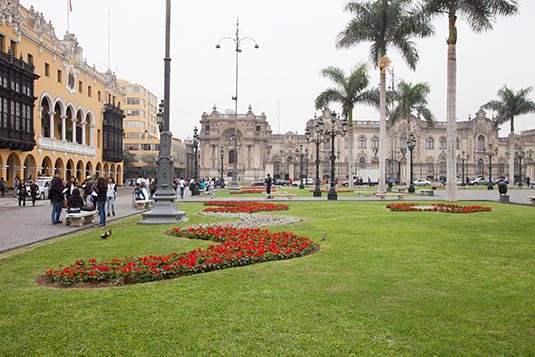 Lima, the Capital City of Peru is known as the 'City of Kings'. Life officially began in 1535, when Spanish conquistador Francisco Pizarro founded the city on the Day of the Three Kings (celebrated on January 6 and considered the last day of Christmas celebrations). Settlements had been scattered through the valley since before the Incas. The city was built on top of an existing palace and temples that belonged to the local chief who had little choice but to move on. 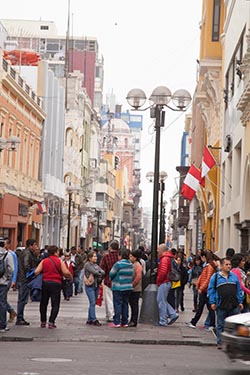 We reached Lima, late in the afternoon from Puno. Lima would be our last stop of our South American trip. For the night we were booked at Casa Andina Private Collection Hotel located in Miraflores. The hotel was an hour's drive from the airport.
We reached Lima, late in the afternoon from Puno. Lima would be our last stop of our South American trip. For the night we were booked at Casa Andina Private Collection Hotel located in Miraflores. The hotel was an hour's drive from the airport.
That evening was free. Most of us decided to have our dinner at an Indian restaurant, a few blocks away from the hotel. Remainder of the night was to be at the casino - there were plenty in the neighbourhood. We were told that Miraflores is a safe district, but advised to stay on the main roads instead of finding shortcuts through alleys. The next morning and little of the afternoon would be spent in exploring the city. Lima was in its prime during the Spanish colonial days and much of the city's attraction now lies in its well-preserved historical centre. And that's where we headed for after breakfast. We were dropped at Plaza Mayor (Main Square). We would be walking around for couple of hours, exploring the Colonial side of Lima. 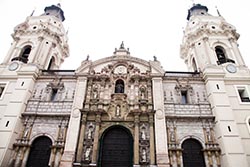 The Plaza Mayor or Plaza de Armas of Lima, is the birthplace of the city, as well as the core of the city. Located in the Historic Centre of Lima, it is surrounded by the Government Palace, Cathedral of Lima, Archbishop's Palace of Lima, the Municipal Palace, and the Palace of the Union.
The Plaza Mayor or Plaza de Armas of Lima, is the birthplace of the city, as well as the core of the city. Located in the Historic Centre of Lima, it is surrounded by the Government Palace, Cathedral of Lima, Archbishop's Palace of Lima, the Municipal Palace, and the Palace of the Union.
During the time of our visit, the government was expecting some kind of a protest gathering. Therefore, the main garden was out bound to visitors. Security forces were all around. Thankfully, it was all peaceful... at least for the time that we were there. 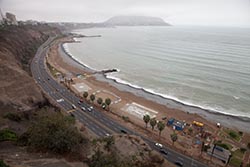 In 1523, King Charles I of Spain mandated the Procedures for the creation of cities in the New World. These procedures indicated that after outlining a city's plan, growth should follow a grid centered on the square shape of the plaza.
In 1523, King Charles I of Spain mandated the Procedures for the creation of cities in the New World. These procedures indicated that after outlining a city's plan, growth should follow a grid centered on the square shape of the plaza.
During the colonial era, the plaza served as a market, bull fighting ring, and the city gallows. The plaza also became home to the Auto de fe in which the inquisition occurred. The tribunal of the inquisition had one of its three courts located in Lima. The first conviction occurred on November 15, 1573 and this was the first heretic to be tried and executed in the new world. 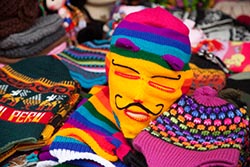 The Basilica Cathedral of Lima is a Roman Catholic cathedral located in the Plaza Mayor. Construction began in 1535, and the building has undergone many reconstructions and transformations since. It retains its colonial structure and facade. It is dedicated to St John, Apostle and Evangelist. The Basilica Cathedral is also home to the tomb of Francisco Pizarro.
The Basilica Cathedral of Lima is a Roman Catholic cathedral located in the Plaza Mayor. Construction began in 1535, and the building has undergone many reconstructions and transformations since. It retains its colonial structure and facade. It is dedicated to St John, Apostle and Evangelist. The Basilica Cathedral is also home to the tomb of Francisco Pizarro.
The Viceroyalty of Peru was a Spanish colonial administrative district, created in 1542, that originally contained most of Spanish-ruled South America, governed from the capital of Lima. The Viceroyalty of Peru was one of the two Spanish Viceroyalties in the Americas from the sixteenth to the eighteenth centuries. 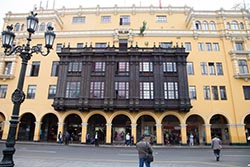 However, the Spanish did not resist the Portuguese expansion of Brazil across the meridian. The Treaty of Tordesillas was rendered meaningless between 1580 and 1640 while Spain controlled Portugal. The creation of Viceroyalties of New Granada and Rio de la Plata (at the expense of Peru's territory) reduced the importance of Lima and shifted the lucrative Andean trade to Buenos Aires, while the fall of the mining and textile production accelerated the progressive decay of the Viceroyalty of Peru. Eventually, the viceroyalty would dissolve, as with much of the Spanish empire, when challenged by national independence movements at the beginning of the nineteenth century. These movements led to the formation of the modern-day countries of Peru, Chile, Colombia, Panama, Ecuador, Bolivia, Paraguay, Uruguay, Argentina, Guyana and Trinidad and Tobago in the territories that at one point or another had constituted the Viceroyalty of Peru.
However, the Spanish did not resist the Portuguese expansion of Brazil across the meridian. The Treaty of Tordesillas was rendered meaningless between 1580 and 1640 while Spain controlled Portugal. The creation of Viceroyalties of New Granada and Rio de la Plata (at the expense of Peru's territory) reduced the importance of Lima and shifted the lucrative Andean trade to Buenos Aires, while the fall of the mining and textile production accelerated the progressive decay of the Viceroyalty of Peru. Eventually, the viceroyalty would dissolve, as with much of the Spanish empire, when challenged by national independence movements at the beginning of the nineteenth century. These movements led to the formation of the modern-day countries of Peru, Chile, Colombia, Panama, Ecuador, Bolivia, Paraguay, Uruguay, Argentina, Guyana and Trinidad and Tobago in the territories that at one point or another had constituted the Viceroyalty of Peru.
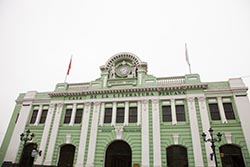 The Government Palace also known as House of Pizarro is the seat of the executive branch of the Peruvian Government and the official residence of the President of Peru. It was erected in 1535 over a huge huaca that had a shrine of the old Lima valley's cacique Taulichusco. It has undergone many transformations over the years. The last one was completed in the 20th century by President Oscar R. Benavides during his second government in the 1930s.
The Government Palace also known as House of Pizarro is the seat of the executive branch of the Peruvian Government and the official residence of the President of Peru. It was erected in 1535 over a huge huaca that had a shrine of the old Lima valley's cacique Taulichusco. It has undergone many transformations over the years. The last one was completed in the 20th century by President Oscar R. Benavides during his second government in the 1930s.
The Government Palace was built by Francisco Pizarro, the governor of New Castile. When the viceroyalty of Peru was established, the palace became the viceroy's residence and therefore the Peruvian government's headquarters. The main architect of its last rebuilding was Ricardo de Jaxa Malachowski. The palace is a stately government building with a set of ornamental guards. It is recognizable by the large wrought iron fence that surrounds the building and lines one side of the Plaza Mayor behind the Rimac River. 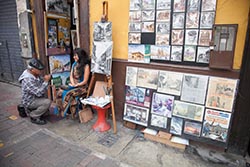 We continued walking to reach the Desamparados Station - an old railway station. It is situated on the left margin of the Rimac River, next to the Government Palace. The station was named after the church of Nuestra Senora de los Desamparados. At present the station only has administrative use, although it can offer passenger excursion services between Lima and the central mountain range. It serves mainly as an exhibition hall.
We continued walking to reach the Desamparados Station - an old railway station. It is situated on the left margin of the Rimac River, next to the Government Palace. The station was named after the church of Nuestra Senora de los Desamparados. At present the station only has administrative use, although it can offer passenger excursion services between Lima and the central mountain range. It serves mainly as an exhibition hall.
Next was the highlight of the day - Convent of San Francisco. Convento de San Francisco is the Spanish name for Saint Francis Monastery. Aside from a church and monastery it also contains a library and catacombs. The church and monastery were blessed in 1673 and completed in 1774. Though it survived several earthquakes intact in 1687 and 1746, it suffered extensive damage in an earthquake in 1970. The church is noted for its architecture, a high example of Spanish Baroque. 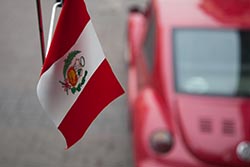 The convent's library is world-renowned. It possesses about 25,000 antique texts, some of them predating the conquest. Some notable books are the first Spanish dictionary published by the Royal Spanish Academy and a Holy Bible edition from 1571- 1572 printed in Antwerp. Other notable possessions are 13 paintings of the biblical patriarch Jacob and his 12 sons in the refectory, by the hand of the studio of the Spanish master Francisco de Zurbaran. The last supper painted by Diego de la Puente depicts typical Peruvian ingredients and meals, instead of European dishes it depicts, such as guinea pig, potatoes and chilies. Also peculiar is the Devil hovering besides Judas. The monastery also possesses several paintings attributed to the school of Peter Paul Rubens.
The convent's library is world-renowned. It possesses about 25,000 antique texts, some of them predating the conquest. Some notable books are the first Spanish dictionary published by the Royal Spanish Academy and a Holy Bible edition from 1571- 1572 printed in Antwerp. Other notable possessions are 13 paintings of the biblical patriarch Jacob and his 12 sons in the refectory, by the hand of the studio of the Spanish master Francisco de Zurbaran. The last supper painted by Diego de la Puente depicts typical Peruvian ingredients and meals, instead of European dishes it depicts, such as guinea pig, potatoes and chilies. Also peculiar is the Devil hovering besides Judas. The monastery also possesses several paintings attributed to the school of Peter Paul Rubens.
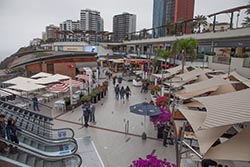 The catacombs in the premises were discovered in 1943. They contain thousands of skulls and bones, having served as a burial-place until 1808, when the city cemetery was opened outside Lima. It is estimated that 25,000 bodies were laid to rest there; the crypts, built of bricks and mortar, are very solid and have stood up well to earthquakes, it is also believed there existed secret passageways that connected to the Cathedral and the Tribunal of the Holy Inquisition. Photography was prohibited in the church and the monastery.
The catacombs in the premises were discovered in 1943. They contain thousands of skulls and bones, having served as a burial-place until 1808, when the city cemetery was opened outside Lima. It is estimated that 25,000 bodies were laid to rest there; the crypts, built of bricks and mortar, are very solid and have stood up well to earthquakes, it is also believed there existed secret passageways that connected to the Cathedral and the Tribunal of the Holy Inquisition. Photography was prohibited in the church and the monastery.
That was it. The bus picked us up from the church gates and dropped us at a shopping mall named Larco Mar. We had to leave for the airport at 9 PM, giving us time to explore the mall. Located in Miraflores, the shopping mall is built on a spectacular cliff overlooking the Pacific Ocean and the traditional Parque del Amor (Love Park). We walked around and had our lunch in one of the mall's many cafes. At 5 PM we were at the tables of a casino. Since luck was on our side, we didn't even realise that it was 8 PM. We quickly rushed to our hotel, picked our bags and were off to the airport to catch our flight back home. Lima Image Gallery  Photo viewer Photo viewer
|
|
|
Home |
Charity |
Feedback
Privacy Policy | Terms of Usage © YoGoYo.com. All rights reserved. |























